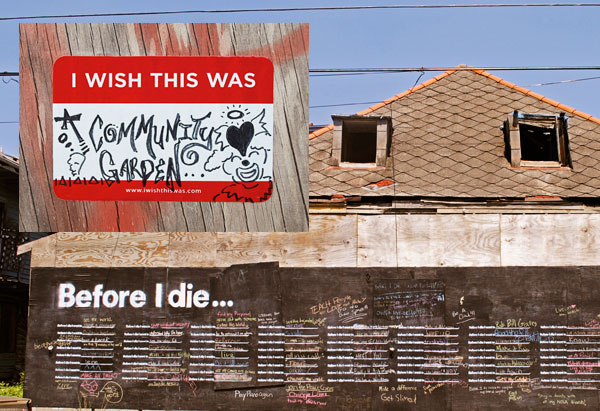How Candy Chang's Public Art Projects Are Changing Communities Everywhere

Photos: Courtesy of Candy Chang
With fill-in-the-blank stencils and stickers, Candy Chang has invited New Orleans residents to share their hopes for the future (above) and for the fate of a vacant building (above left).
In 2007 Candy Chang—then pursuing her master's in urban planning at Columbia University—was offered a fellowship in a township in Johannesburg, South Africa, to help develop more efficient ways for the community to share information. New systems were sorely needed: Before Chang arrived, a young girl had wandered from home and been lost for three days. Though she was ultimately returned safe and sound to her family, the township's lack of neighborhood-wide communication—like a local radio station—had hindered the search. Chang's team devised a simple but brilliant solution: They installed blackboards in high-traffic areas, allowing residents to spread news, publicize events, and post jobs. The experience convinced Chang that better use of our public spaces could revolutionize how we interact in our communities—and give us a greater say in what happens to them. Through a series of large-scale projects that combine installation art with social activism, Chang has encouraged people to engage with public spaces to let their voices be heard. In 2008, while living in New York, she invited Brooklyn residents to anonymously reveal their rental costs on sticky notes posted on a local storefront—helping them determine the fair market value of their apartments. In 2011 she constructed a blackboard over an abandoned house in her current city of New Orleans, stenciling it with the phrase BEFORE I DIE I WANT TO.... Passersby wrote in answers like "go to school," "feed an elephant," and "understand," in chalk. Chang says the project served as a reminder of "what matters to people as individuals and as a community."
In April she revisited the chalkboard idea in Fairbanks, Alaska, erecting one outside a high-rise that's stood empty for a decade. This time locals were prompted to share their memories of what the building had been, and their hopes for what it might become: a gym, a skating rink, an Indian restaurant. After all, says Chang, "the residents who patronize local businesses should have a say in what new businesses open."
Chang's ultimate goal is to get people invested in their communities by helping them voice their opinions—on-site and in real time. "Where better to shape our public spaces," she says, "than in the spaces themselves?"
More Ways to Stay Connected



